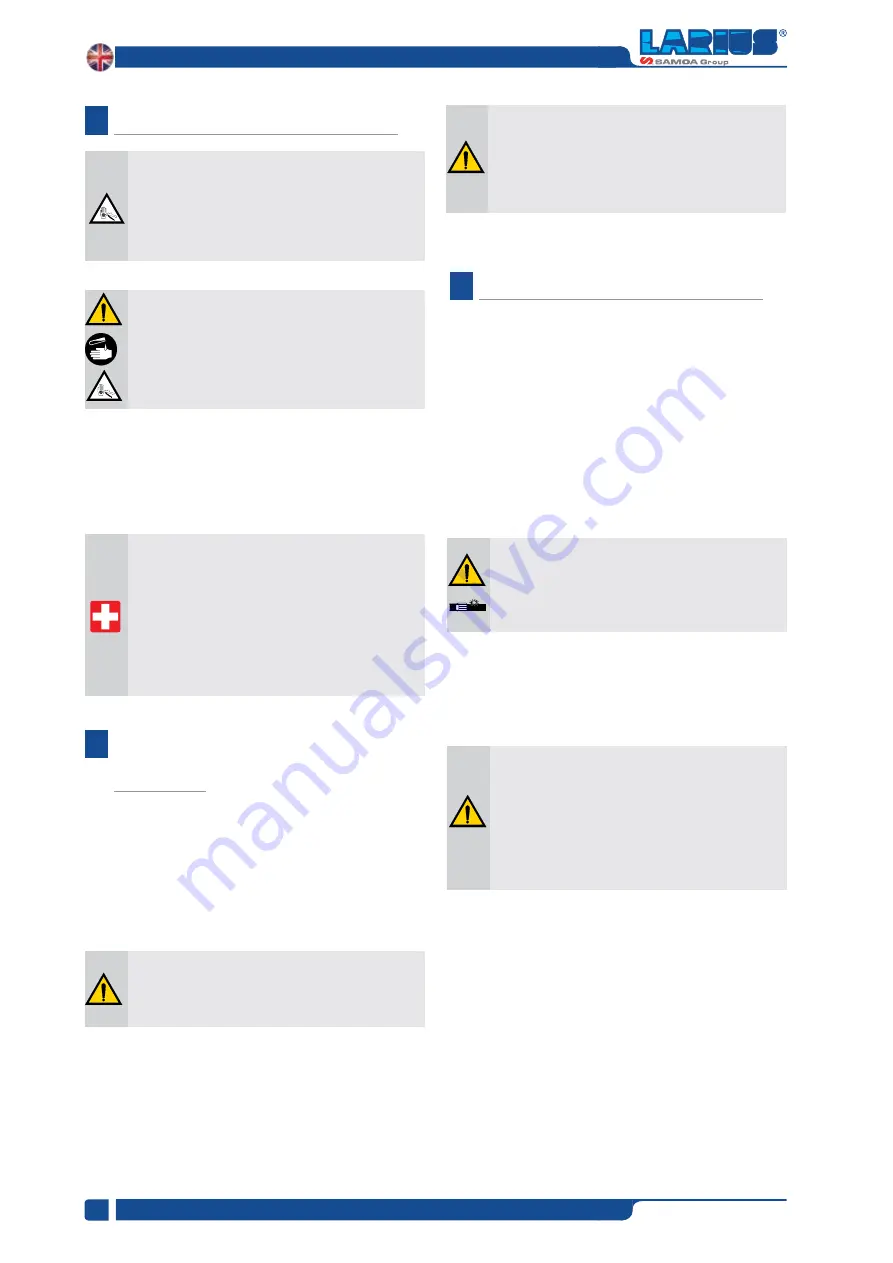
www.larius.com
14
L200 - L201
REV.
01 - 01/2020 - Cod. 150084
The fluid in the feed hose may be extremely hazardous. If there is
a leak from the hose or a cut or rupture due to wear or damage or
incorrect use, the fluid that leaks out may cause fluid penetration
damage or may seriously damage objects.
Any misuse of the dispensing equipment or accessories,
such as overpressurizing, modifying parts, using incompatible
chemicals and fluids, or using worn or damaged parts, can
cause them to rupture and result in serious injury, including fluid
injection and splashing fluid in the eyes or on the skin, or in fire,
explosion or property damage.
• Do not attempt to reconnect the feed hoses or repair them with
tape or any other method.
• Handle and route hoses carefully.
MEDICAL ALERT – FLUID INJECTION WOUNDS
If any fluid appears to penetrate your skin, get EMERGENCY
MEDICAL CARE AT ONCE. DO NOT TREAT AS A SIMPLE CUT.
Tell the doctor exactly what fluid was injected.
• Tighten all fluid connections securely before each use.
High pressure fluid can dislodge a loose coupling or allow high
pressure fluid to be emitted from the coupling
• Never use a damaged hose. If any of these conditions exist,
replace the hose immediately.
Proper hose grounding continuity is essential to maintaining a
grounded dispensing system. Check the electrical resistance of
your fluid hoses at least once a week. If your hose does not have
a tag on it which specifies the maximum electrical resistance,
contact the hose supplier or manufacturer for the maximum
resistance limits.
Use a resistance meter in the appropriate range for your hose to
check the resistance. If the resistance exceeds the recommended
limits, replace it immediately. An ungrounded or poorly grounded
fluid hose can make your system hazardous.
Be sure that all dispensing equipment and accessories are
properly rated to withstand the pressures developed by your
system. Never exceed the maximum working pressure of your
gun model.
J
The fluid that the spray gun shoot may penetrate the
skin and body causing severe damage, including
the need for amputation. Fluid that penetrates or
is sprayed into the eyes or onto the skin can also
cause serious injury.
Injection into the skin is a traumatic injury.
It is important to treat the injury surgically as
soon as possible. Do not delay treatment to
research toxicity.
Toxicity is a concern with some exotic materials
injected directly into the blood stream.
Consultation with a plastic surgeon may be
advisable.
EQUIPMENT MISUSE
HAZARD
J
The maximum working pressure of the gun is
280 bar. Do not exceed the maximum Working
pressure.
Do not place hands or fingers on the nozzle.
Do not clean the residues that form around the
nozzle until the pressure has been completely
discharged. Do not try and stop leaks with your
hands or body.
Be sure all fluids and solvents used are chemically
compatible with the “WETTED PARTS” shown in
the TECHNICAL DATA. Always read the fluid and
solvent manufacturer’s literature before using any
fluid or solvents in your system.
FLUID INJECTION HAZARD
I
Before each use, check the entire hose for cuts,
leaks, abrasion, bulging cover, or damage or
movement of the hose couplings.
Do not pull on hoses to move equipment.
Do not use fluids or solvents which are not
compatible with the inner tube and cover of the
hose.
Do not expose hose to extreme temperatures;
check with your hose supplier to determine
temperature tolerance.
K
FLUID INJECTION HAZARD















































